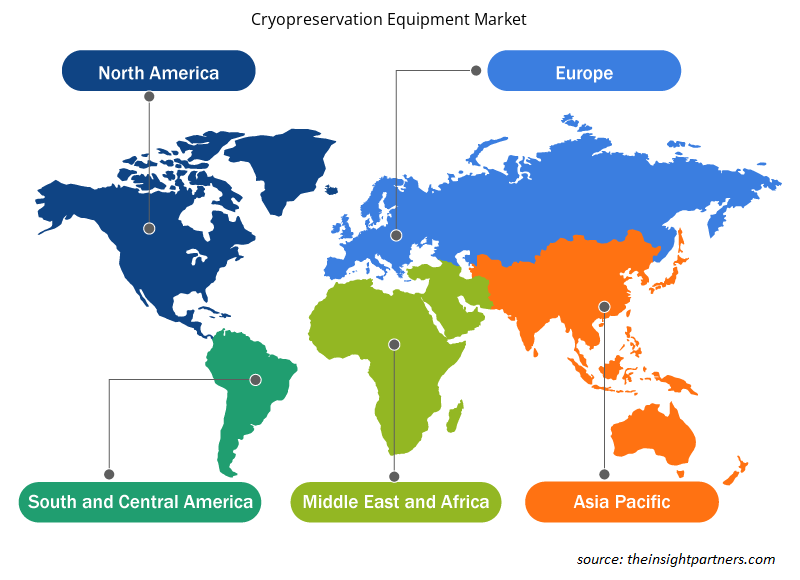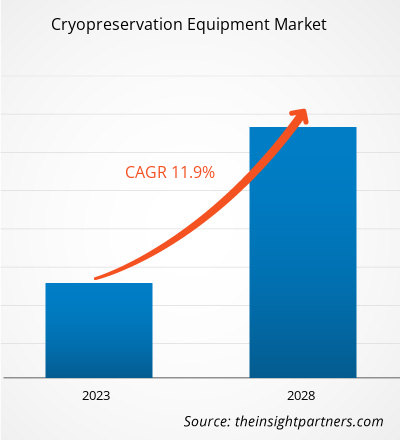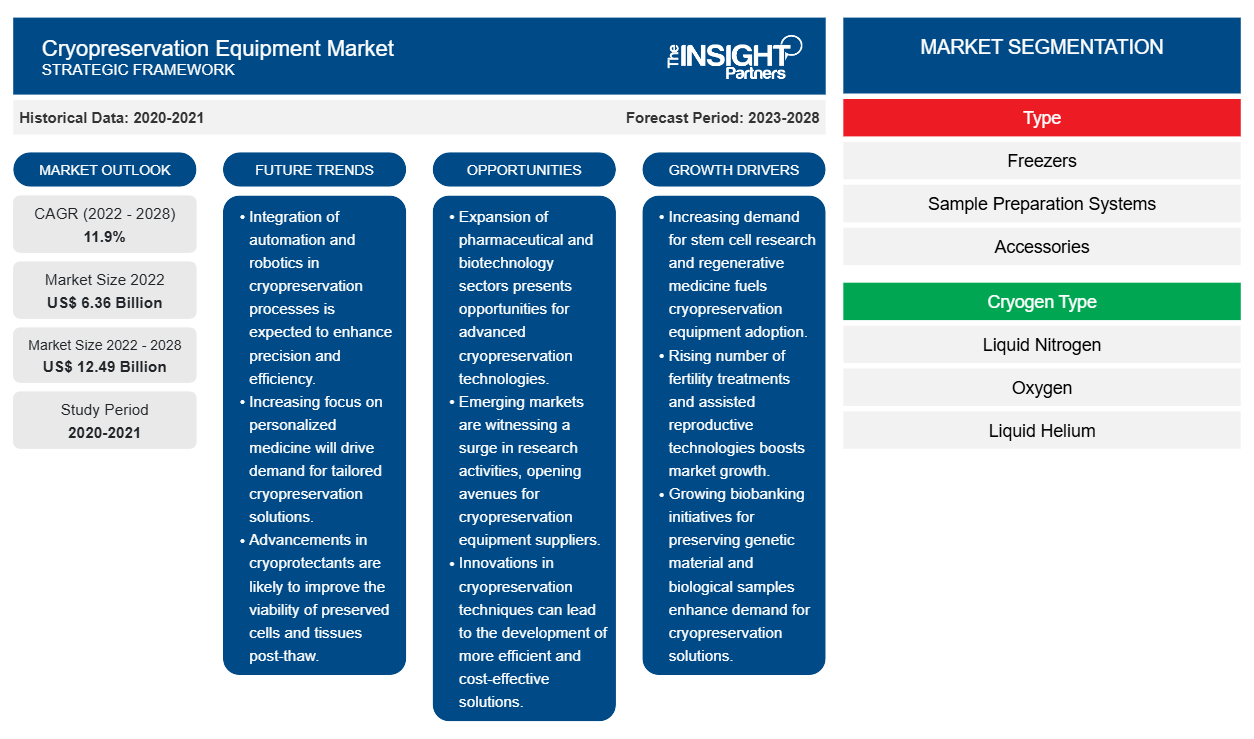预计到 2028 年,冷冻保存设备市场规模将从 2022 年的 63.5865 亿美元增至 124.8984 亿美元;预计从 2022 年到 2028 年,复合年增长率为 11.9%。
低温保存是一种技术,用于最大限度地减少冷冻和储存生物材料(如组织、细菌、真菌、病毒和哺乳动物细胞)期间造成的细胞损伤。通过低温保存保存的组织和遗传稳定的活细胞可用于研究和其他生物医学应用。低温保存所需的设备包括低温保存系统、低温器皿、配件和低温剂。
低温保存设备市场根据类型、低温类型、应用、最终用户和地理位置进行细分。按地理位置划分,市场大致分为北美、欧洲、亚太地区、中东和非洲以及南美和中美洲。该报告提供了对市场的深入分析和见解,重点关注市场趋势、技术进步和市场动态等参数,以及对全球领先市场参与者的竞争格局的分析。
定制此报告以满足您的需求
您可以免费定制任何报告,包括本报告的部分内容、国家级分析、Excel 数据包,以及为初创企业和大学提供优惠和折扣
- 获取此报告的关键市场趋势。这个免费样品将包括数据分析,从市场趋势到估计和预测。
市场洞察
再生医学的接受度不断提高推动低温保存设备市场增长
冷冻保存在再生医学领域发挥着重要作用,因为它有助于长期稳定安全地储存细胞和其他相关成分。再生医学能够通过干细胞疗法恢复患病或受损的细胞、组织和器官的正常功能,从而替换它们。由于医疗技术的进步,干细胞疗法现在被视为治疗多种慢性疾病(包括糖尿病和神经退行性疾病)的传统药物疗法的替代方案。此外,美国食品药品监督管理局 (FDA) 已批准造血干细胞。造血干细胞也称为造血祖细胞,源自脐带血。干细胞和基因疗法的批准越来越多,最终导致对冷冻保存设备的需求旺盛。以下是 FDA 和其他监管机构批准的一些干细胞和基因疗法实例。
- 2021 年 2 月,百时美施贵宝公司(Juno Therapeutics, Inc.)获得 FDA 批准,用于治疗 CD19 导向的嵌合抗原受体 T 细胞 (CAR-T) 疗法 Breyanzi。该 CAR-T 细胞疗法用于治疗成人复发或难治性大 B 细胞淋巴瘤。
- 2021 年 3 月,诺华公司获得新加坡卫生科学局批准,将首个 CAR-T 疗法 Kymriah 商业化,该疗法据称是针对每位患者单独进行的一次性治疗程序。该疗法根据新的细胞、组织和基因治疗产品 (CTGTP) 监管框架获得批准。
- 2020年7月,吉利德旗下Kite公司的Tecartus(原名KTE-X19)CAR-T细胞疗法获得美国FDA批准,用于治疗复发或难治性套细胞淋巴瘤(MCL)成年患者。
- 2019年5月,Vericel Corporation的MACI(猪胶原膜上自体培养软骨细胞)获得批准。
- 2017年12月,Spark Therapeutics公司的Luxturna获得美国FDA批准,这是一款一次性基因治疗产品,用于治疗确诊的双等位基因RPE65突变相关视网膜营养不良症患者。
生物银行实践需求的不断增长显著促进了市场增长
生物库被广泛用于保存生物材料,包括人类生物制剂、植物、动物和微生物,用于医学研究、药物开发、农业和生态学。过去几年,生物技术和制药制造商、合同研究组织、干细胞库和干细胞研究实验室对冷冻保存设备的需求不断增加。这些最终用户为生物标志物检测、分子诊断、转化医学和多学科疾病研究的发展做出了贡献。此外,用于研究遗传和环境或生活方式因素之间相互作用的生物材料也可以储存在生物库中。他们需要冷冻保存设备来储存脐带血作为造血干细胞和祖细胞的来源;癌组织样本;用于人工授精的精液;用于体外受精 (IVF) 的卵母细胞和胚胎;以及用于育种的植物种子/幼苗。此外,COVID-19 大流行引发了有效诊断和治疗方法的研究和开发活动,这增加了对生物库的需求。
格拉茨生物库、上海张江生物库、“我们所有人”生物库、国际癌症研究机构 (IARC) 生物库 (IBB)、中国嘉道理生物库、英国生物库、FINNGEN 生物库、加拿大明日伙伴计划生物库、欧洲生物库网络和卡塔尔生物库是全球领先的生物库。它们是国家政府资助的人口健康研究的一部分。除了列出的生物库外,各个地区的私营和公共实体拥有的其他各种生物库都需要大量冷冻保存设备和配件。
类型洞察
根据类型,全球低温保存设备市场分为冷冻机、样品制备系统和配件。2020 年,冷冻机占据了最大的市场份额,预计在 2022-2028 年期间将实现最高复合年增长率。在超低温冷冻机中,液氮用于通过几乎捕获所有生物活动来成功保存更复杂的生物结构。
制冷剂类型洞察
根据低温保存类型,全球低温保存设备市场分为液氮、氧气、液氦、氩气等。2020 年,液氮占据了最大的市场份额,预计在 2022-2028 年期间将以最高复合年增长率增长。液氮是一种非机械的细胞保存方法。大型热水瓶状容器用于放置放置低温小瓶的架子或搁板。
应用程序洞察
根据应用,全球冷冻保存设备市场细分为脐带血干细胞、精子、精液和睾丸组织、胚胎和卵母细胞、细胞和基因疗法等。2020 年,脐带血干细胞细分市场占据了最大的市场份额。此外,精子细分市场预计将在 2022-2028 年期间实现最高的复合年增长率。近年来,公共脐带血库比私人脐带血库更受推崇。世界各地的各种中心都在进行脐带血干细胞移植,作为管理遗传、血液、免疫、代谢和肿瘤等疾病的一部分,这促进了公共脐带血库细分市场的增长。
最终用户洞察
根据最终用户,冷冻保存设备市场细分为干细胞库、生物技术和制药组织、干细胞研究实验室等。生物技术和制药组织部门在 2020 年占据了最大的市场份额,预计到 2028 年将成为市场的最大股东。冷冻保存已成为许多细胞疗法制造过程不可或缺的一部分,因为它有时是作为细胞培养(在开始大规模制造之前保存起始细胞材料)之前的步骤进行的,并且通常在细胞扩增之后进行。
产品发布和并购是全球低温保存设备市场参与者最常采用的策略。以下列出了一些近期的关键产品开发:
- 2021 年 5 月,Stirling Ultracold 被 BioLife Solutions, Inc 收购,用于细胞和基因疗法以及更广泛的生物制药市场。作为对 Stirling 全部流通股的回报,BioLife 发行了 6,646,870 股普通股。
- 2019年12月,PHC公司推出了新型超低温MDF-DU901VHL(大型900升级),采用最新的机柜设计和直观的LCD显示控制(ECO版)。
COVID-19 疫情对冷冻保存设备市场的影响喜忧参半。由于计划生育服务受限、经济不确定性和衰退导致人们注意力分散以及工作与生活平衡被打乱,疫情期间生育诊所的卵子和胚胎冷冻活动增加。因此,冷冻保存设备的使用增加推动了市场增长。此外,由于港口拥堵和其他交通工具的干扰导致供应链中断,严重影响了冷冻保存设备和其他配件的分销。
低温保存设备市场区域洞察
Insight Partners 的分析师已详尽解释了预测期内影响低温保存设备市场的区域趋势和因素。本节还讨论了北美、欧洲、亚太地区、中东和非洲以及南美和中美洲的低温保存设备市场细分和地理位置。

- 获取低温保存设备市场的区域特定数据
低温保存设备市场报告范围
| 报告属性 | 细节 |
|---|---|
| 2022 年市场规模 | 63.6亿美元 |
| 2028 年市场规模 | 124.9亿美元 |
| 全球复合年增长率(2022 - 2028) | 11.9% |
| 史料 | 2020-2021 |
| 预测期 | 2023-2028 |
| 涵盖的领域 | 按类型
|
| 覆盖地区和国家 | 北美
|
| 市场领导者和主要公司简介 |
|
低温保存设备市场参与者密度:了解其对业务动态的影响
低温保存设备市场正在快速增长,这得益于终端用户需求的不断增长,而这些需求又源于消费者偏好的不断变化、技术进步以及对产品优势的认识不断提高等因素。随着需求的增加,企业正在扩大其产品范围,进行创新以满足消费者的需求,并利用新兴趋势,从而进一步推动市场增长。
市场参与者密度是指在特定市场或行业内运营的企业或公司的分布情况。它表明相对于给定市场空间的规模或总市场价值,有多少竞争对手(市场参与者)存在于该市场空间中。
在低温保存设备市场运营的主要公司有:
- 赛默飞世尔科技公司
- Gold Sim 细胞科学有限责任公司
- 布鲁克斯自动化有限公司
- Avantor 公司
- 汉密尔顿公司
免责声明:上面列出的公司没有按照任何特定顺序排列。

- 了解低温保存设备市场主要参与者概况
低温保存设备市场 - 细分
根据类型,冷冻保存设备市场分为冷冻机、样品制备系统和配件。根据冷冻剂类型,冷冻保存设备市场分为液氮、氧气、液氦、氩气等。根据应用,冷冻保存设备市场分为脐带血干细胞、精子、精液和睾丸组织、胚胎和卵母细胞、细胞和基因疗法等。根据最终用户,冷冻保存设备市场分为干细胞库、生物技术和制药组织、干细胞研究实验室等。按地域划分,市场分为北美(美国、加拿大和墨西哥)、欧洲(英国、德国、法国、意大利、西班牙和欧洲其他地区)、亚太地区(中国、日本、印度、澳大利亚、韩国和亚太地区其他地区)、中东和非洲(阿联酋、沙特阿拉伯、南非和中东和非洲其他地区)以及南美洲和中美洲(巴西、阿根廷和南美洲和中美洲其他地区)。 冷冻保存设备市场的知名企业包括赛默飞世尔科技公司、Gold Sim Cellular Science LLC、Brooks Automation, Inc、Avantor, Inc.、Hamilton Company、PHC Holdings Corporation、Danaher Corporation、Cryoport Systems, LLC.、Antech Group Inc.、Cryofab、BioLife Solutions 和中科美灵低温技术有限公司。
- 历史分析(2 年)、基准年、预测(7 年)及复合年增长率
- PEST和SWOT分析
- 市场规模、价值/数量 - 全球、区域、国家
- 行业和竞争格局
- Excel 数据集
近期报告
相关报告
客户评价
购买理由
- 明智的决策
- 了解市场动态
- 竞争分析
- 客户洞察
- 市场预测
- 风险规避
- 战略规划
- 投资论证
- 识别新兴市场
- 优化营销策略
- 提升运营效率
- 顺应监管趋势





















 获取免费样品 - 低温保存设备市场
获取免费样品 - 低温保存设备市场